Supporting Multilingual Learners (MLs) through translation is essential when you’re a content teacher who has a newcomer or emergent multilingual student in your class. Having translation resources in place makes content instantly accessible (for those who have primary language literacy). This is a strong step into providing MLs content that is comprehensible. I will forever be a proponent of translation and translanguaging in the classroom! As those students advance in English learning, however, let’s consider…
While full translation of content into the primary language of MLs is certainly a valuable approach at times, is reliance on it 100% of the time what’s best for the students? If not, many teachers then wonder: “What strategies CAN we turn to for making instruction accessible?”
If you’re supporting multilingual learners and are asking, “What’s the right balance between all translation and no translation?”, this blog may help you gain some new understandings, and hopefully some helpful next steps.
Multilingual Learners Definition
First, a brief multilingual learners definition, to clarify this terminology, in case you are unfamiliar. Multilingual learners (MLs) are our students who are exposed to, communicate in, and/or are developing fluency in two or more languages.
Although the term English learners may fall under the umbrella of Multilingual Learners, many entities and institutions have adopted the use of ML. This is largely because ML provides a more assets-affirming designation. It recognizes the value of developing communication skills in multiple languages, and celebrates multilingualism in the school setting.
Terminology used in various contexts is flexible, but for this blog I will use the term multilingual learners.
Equity and Student Rights: Getting on the Same Page
We should proceed with a consensus regarding student rights and teacher responsibilities. Supporting multilingual learners is in the interest of every stakeholder, as an increasing percentage of our student populations are MLs. It is the responsibility of every educator to know, understand, and tailor instruction for the MLs they work with. Federal law states that MLs must be given access to the full range of educational activities, as well as instruction for English language development. (See Civil Rights Act of 1964, Lau vs. Nichols case of 1974, and the Dear Colleague Letter of 2015.)
For those providing gen. ed. instruction, this means we must present instruction that our MLs can access and engage in, through scaffolding, accommodations, and yes, translation.
The Translation Temptation
I cannot go without acknowledging that content teachers have a LOT on their plates. Many of my colleagues have the best of intentions and long to do more to support their ML students. Lack of time, training, or collaborative planning leaves them reaching for the closest instructional levers to pull to meet all learners’ needs. Often, this means that the most differentiation they can provide is full translation of content. Google Translate gets a good workout, and MLs can work their way through learning activities.
The temptation for teachers is to continue in the easy rhythms of translation, resting in the knowledge that the students can potentially access everything. Easy-peasy, right?
But what if continued reliance on translation is actually hampering MLs’ progress? Will the ML students’ time with a language specialist be sufficient for English development…or might content teachers also wear the hat of “language coach?”
Supporting Multilingual Learners by Nurturing Content and Language Growth
Here’s the thing. We know that new language acquisition is best supported in authentic learning environments where peer interaction takes place. We know that when language learning is embedded in a relevant context (i.e. grade-level content), English development accelerates.
Our MLs spend the great majority (if not all) of their school day in the gen. ed. classroom setting.
The clear conclusion we can draw is that there are incredible opportunities before us to invite MLs into language learning alongside content learning. Integrating the two will provide incredibly impactful experiences.
Consider, too, that often the academic language coaching offered in the gen. ed. setting will be supportive of all learners in the classroom.
So, if all material is being translated for students, and no effort is given to nurturing their English growth, we are depriving them of countless rich learning opportunities! The goal is to gradually shift from mostly translation to using translation to support instruction which is scaffolded and highlights academic language.
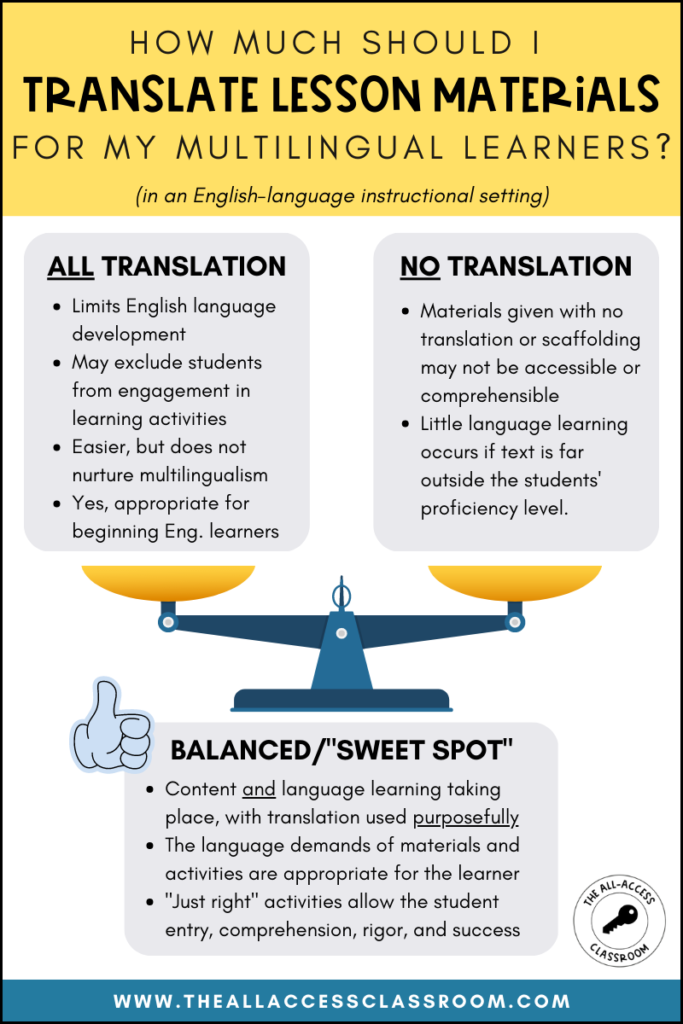
Moving Out of the Shallow End
The shallow end of a swimming pool is so nice. Our feet rest securely on the bottom, and we don’t need to exert any effort to keep ourselves above water. We also will never really learn how to swim, though, until we take steps into deeper water. We get more comfortable treading water, floating, then swimming completely on our own.
After getting used to the feel of the “water,” our newcomers need language coaches (both ML specialists AND their content teachers) who can intentionally guide them in learning English. If we say, “Oh, they’ve got their translation…” and let them stay in the shallow end…well you get the picture.
The solution, then, is to utilize translation in a measured, purposeful way, as we present scaffolded material and comprehensible input for students. Approachable, yet rigorous learning activities will both support MLs and propel them forward.
Translation is a great resource to support:
- Newcomer understanding where heavy content needs to be understood
- Clarification of directions given
- Vocabulary growth
- Connecting languages by identifying cognates
- Communication with students’ families
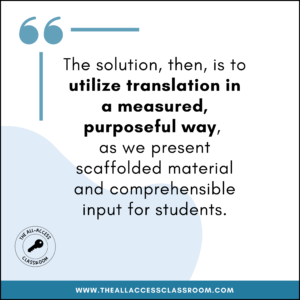
Resources Needed to Make Effective Differentiation for MLs Possible
Now obviously, supporting multilingual learners through scaffolded, comprehensible input is easier said than done. It requires knowledge of the MLs, thoughtful instructional planning, and practice.
Some resources that teachers will need in order to move beyond the 100% translation approach are:
- Planning time
- Teacher training on how to scaffold instruction
- Collaborative structures and teacher partnerships
- Knowledge of students
- Understanding of English language development
Without these, teachers may find they only have energy to create a translated version of materials and be done with it. Understandably, it can be frustrating to have a sense of what needs to be done, but lack the resources to do it.
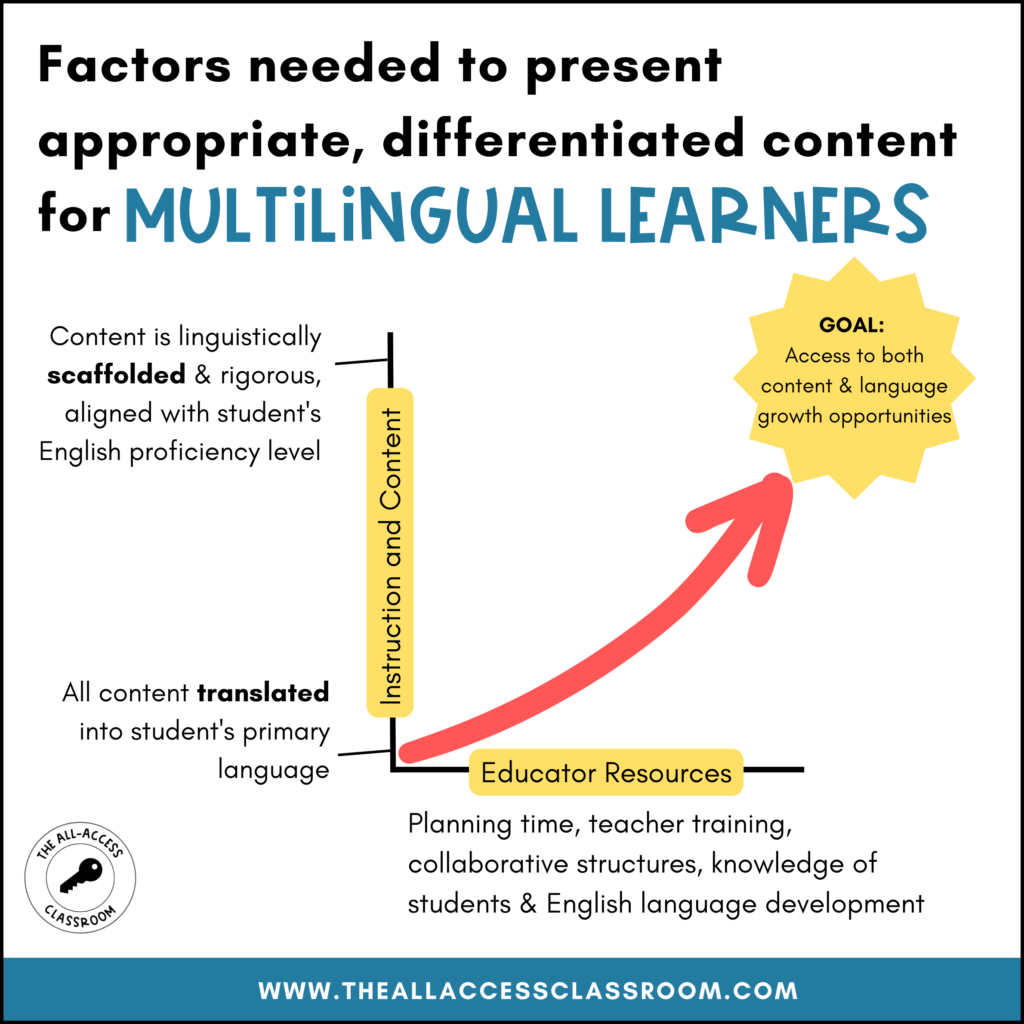
If Limited in These Resources, But Wanting to Move Past the Translation Default…
If you find yourself feeling “stuck” due to lack of the above resources, I encourage you to speak to administrators to advocate for your needs. Explain what might be possible with greater time and collaboration.
Also, seek out your own professional development as you learn more about how MLs learn a new language, and how you can be that language “coach” for them. Talk to your ML Specialist, or check out the All-Access Instruction course for further learning.
If you’re honestly in a place where pushing out translation for your MLs is about all you have energy for…
…First of all, thank you for doing that. Thank you for doing the best you can, with what you have. Keep doing whatever you need to do to help your students access learning. (Yes, even if that means translating everything. We would rather your students be able to understand everything and feel confident, than feel isolated, frustrated and disengaged because they understand nothing.)
And when you DO find some mental space while planning or teaching, you might ask yourself in the moment:
- “What juicy English words pertain to this content, and would be really helpful for my MLs to know in the future?”
- “What is the essential question, theme, or core objective/skill that I need my MLs to leave this unit with? How can I challenge them to engage with this, even if in a different way than their peers?”
- “How can I support the reading of a complex text by summarizing, adding visual or video content, or making my most valuable learning points visible for all students?”
- “What are some academic phrases my students might use when they write or talk about ___? Can I explicitly teach and model these?”
- “How can I do my regular presentation-based teaching, but add a visual component whenever possible?”
All of these questions can get your brain thinking like a language coach. You don’t have to have an ESL certification. And you don’t need to do ALL the things perfectly. But language learning opportunities already abound in your classroom, if you’re willing to seek them out. 🙂
Other thoughts:
Newcomers:
Yes, especially for first-language-literate older students in classes packed with content, it is absolutely helpful to enable full translation, so that instruction and assessment can take place. As this happens, look for opportunities to highlight language in comprehensible ways for your newcomers, so that they’re learning both content and language. Actively monitor and taper translation, as it’s replaced with scaffolded activities/text. This tapering applies to peer/buddy translators, too.
Personal translation devices:
I’m not a fan. Yes, cool for a short-term trip overseas, but for students, this could really isolate them from the class community and language practice opportunities.
Lessening translation does not mean shutting out languages other than English:
We aim to maintain a classroom culture that is assets-based and linguistically-inclusive. We can do this by opening opportunities for translanguaging, helping our MLs feel comfortable using their home language for learning.
Conclusion
Your teaching context is certainly unique, and only you know your students, your abilities, and your resources. My hope is that you can gather up all this information and determine for yourself what the “right balance” looks like when it comes to translation. Please avoid placing judgment on yourself or your own teaching, and put your energy into learning more about the kind of instruction that works for your students. We are all in process, and you are already headed in the right direction!
Blessings, friend,

More resources you might like:
How to Scaffold for ELLs So They Can Better Comprehend Grade-Level Text
Language Acquisition: An Overview – from Colorin Colorado
Digital Frayer Model Templates for Building Vocabulary

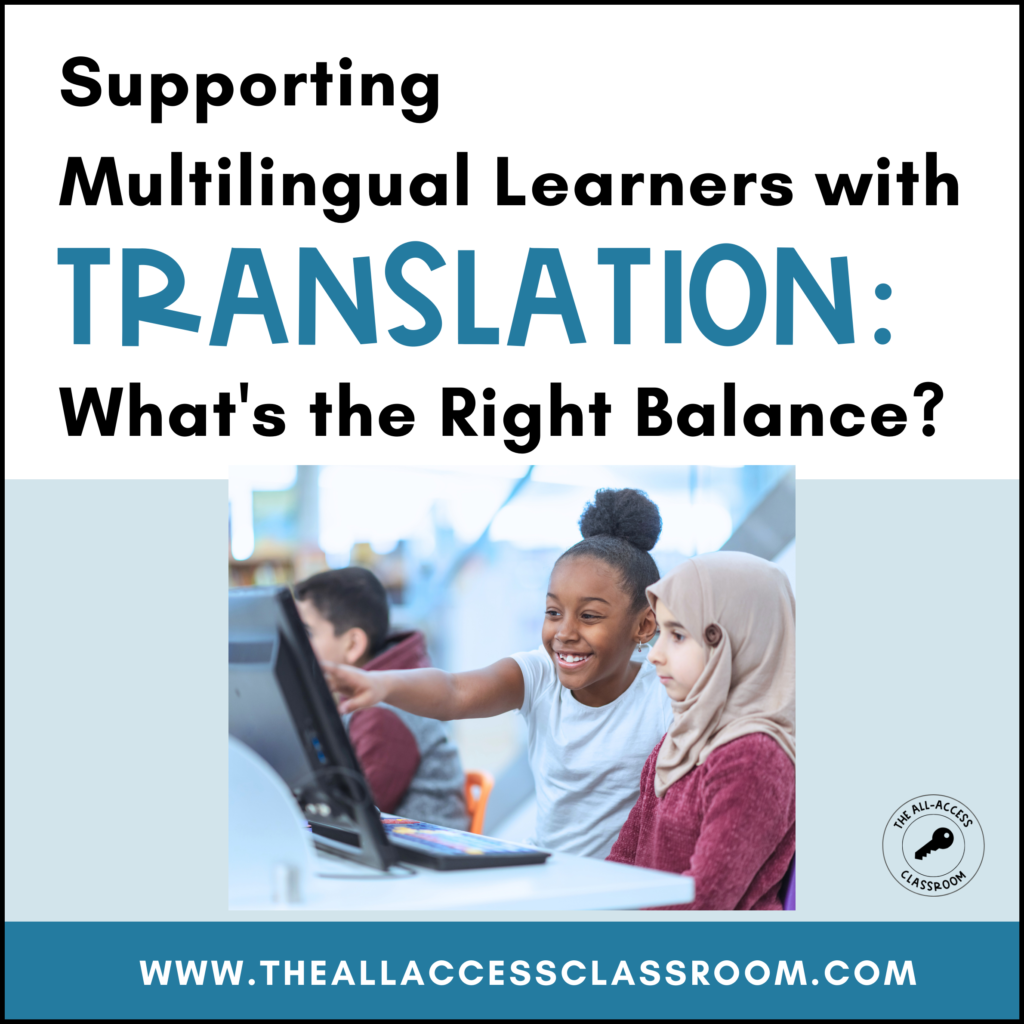
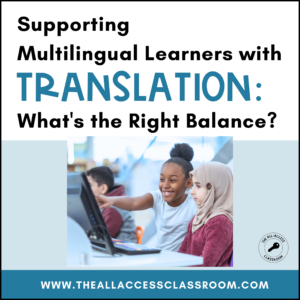
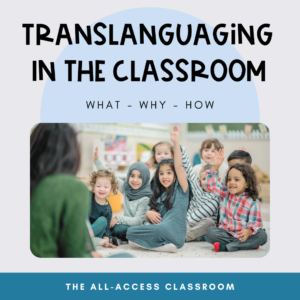
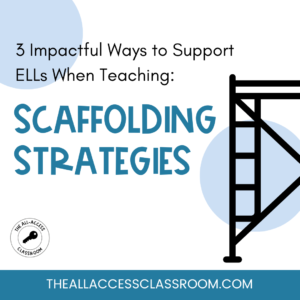
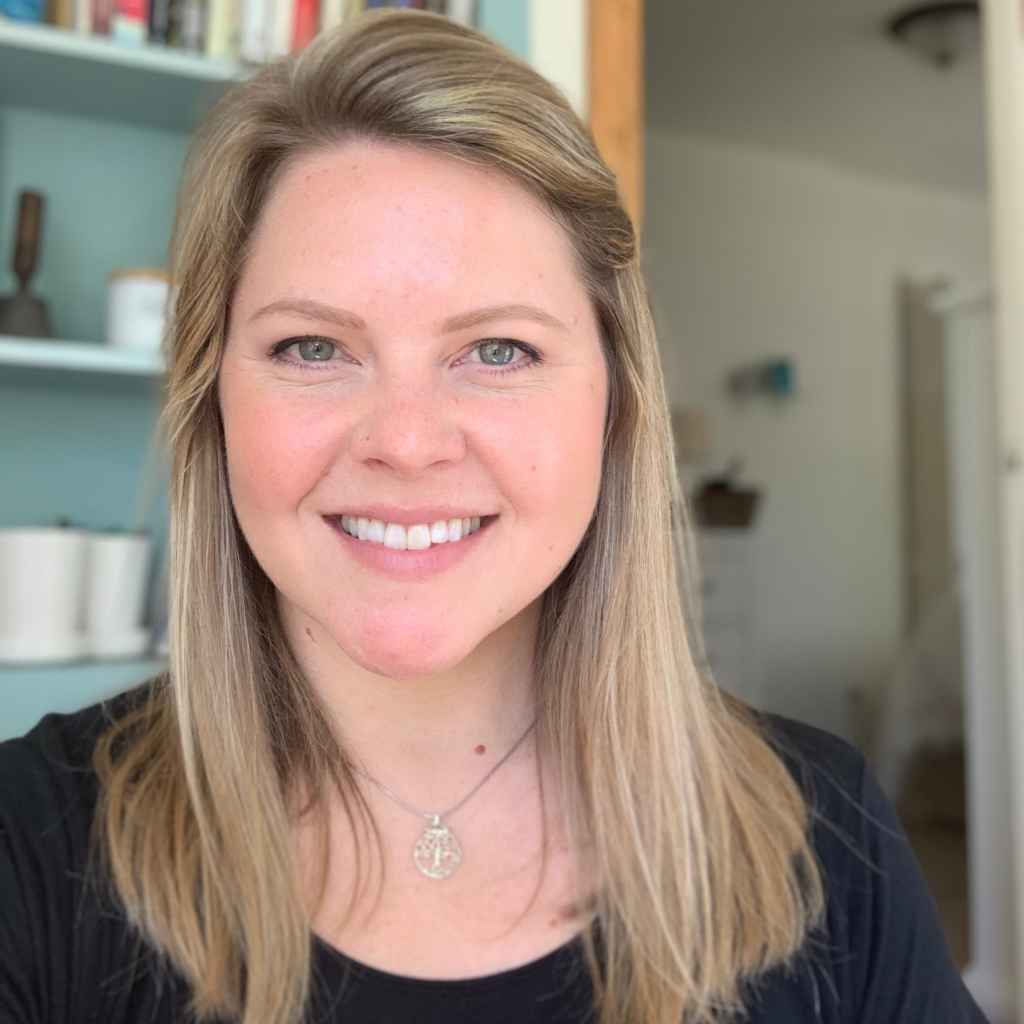
2 Responses
H! Would you happen to have a list of Learning Objectives? I find it difficult to come up with my own and sometimes I doubt that they are correct. I would like to have a resource where I can easily find a language objective. Any suggestions are greatly appreciated. Thank you!
Hi Raquel! Thank you for your question! I love that you are exploring language objectives! Yay! To me, writing a language objective for a lesson is very much informed by the content objectives of that lesson. It is very unique to each instructional activity. I do have another blog post on how to write language objectives, which might be helpful. Or if you’re in a WIDA state, using the English Language Development standards (free on WIDA’s website) is a great way to get more familiar with how language objectives fit in the classroom. If you’re interested in something more in-depth, I have an online course called All-Access Instruction, where we dive into this topic a bit more! I hope this helps you, and thank you for your good work! -Courtney